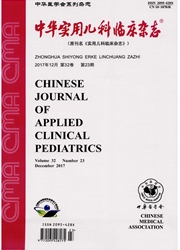

 中文摘要:
中文摘要:
目的建立一种重复性好、可靠的小鼠肝外胆管上皮细胞(MEBECs)体外分离、原代培养的方法。方法Ⅰ型鼠尾胶原包被塑料培养瓶。将10只腹腔注射了7次新生牛血清(NBS)的BALB/c小鼠处死,分离并取出肝外胆管组织,将其剪至1mm3大小后,先采用2.5g/L胰酶和2×10^4U/LDNaseⅠ,再用2×10^5U/LⅣ型胶原酶消化、分离小鼠肝外胆管组织为细小、均匀的细胞团进行接种,接种的细胞团采用含100mL/L的胎牛血清(FBS)、10μg/L表皮生长因子(EGF)DMEM/HamsF12(1:1)培养基进行原代培养。倒置显微镜下观察其细胞形态,噻唑蓝(MTT)法测细胞生长曲线,分别用细胞角蛋白19抗体(anti-CK19)免疫细胞化学染色和透射电镜对所分离的细胞进行鉴定。结果细胞在接种24~48h贴壁增殖,形成大小不等的细胞岛。在接种1周内生长旺盛,第3、4天达到峰值,呈典型的鹅卵石样表观。anti-CK19免疫细胞化学染色,细胞质呈棕黄色着色,细胞核蓝色,呈阳性表达;透射电镜观察,MEBECs表面可见短而多的微绒毛,胞内线粒体、粗面内质网丰富,可见少量脂滴。结论此培养方法是一种可靠的MEBECs的分离纯化培养技术,为体外研究肝外胆管上皮病变提供了实验平台。
 英文摘要:
英文摘要:
Objective To develop a duplicable and reliable method for isolation,primary culture of murine extrahepatic bile duct epithelial cells (MEBECs) in vitro.Methods The plastic culture flask was coated by rat-tail collagen typeⅠ.Ten BALB/c mice were given newborn bovine serum (NBS) by intraperitioneal injections for total 7 times injections were sacrificed.Extraheptic bile ducts were disssected and took out,then were minced into 1 mm3 pieces.The pieces were digested with 2.5 g/L trypsin in the presence of 2×10^4 U/L DNaseⅠand further digested with 2×10^5 U/L collagenase Ⅳ.MEBECs were isolated and seeded in a culture flask containing DMEM/HamsF12(1:1) supplemented with 100 mL/L fetal bovine serum(FBS) and 10 μg/L epithelial growth factor(EGF).Then the morphologic changes of the cells were observed under an inverted light microscope and the growth curve of the cells was determined by 3-(4,5-dimethylthiazol-2-yl)-2,5-diphenytetrazolium bromide(MTT) assay.The nature of the cells was identified by anti-cytokeratin 19 (anti-CK19)staining and transmission electron microscopy.Results The primary cultured cells attached within 24-48 h of seeding and proliferated in an island-like monolayer.These cells grew vigorously within 1 week and reached the maximum at the 3rd to 4th days and displayed the typical cobblestone appearance.anti-CK19 expressed positive,the cytoplasm showed brown and the cell nucleus was blue.Transmission electron microscope showed typical bile duct epithelia with microvilli on the cells surface,massive mitochondria and rough endoplasmic reticulum in the cells.Conclusions This culture technique might be a reliable method for isolation,purification and primary culture of MEBECs.These cells can serve as a material for advanced study in vitro.
 同期刊论文项目
同期刊论文项目
 同项目期刊论文
同项目期刊论文
 期刊信息
期刊信息
